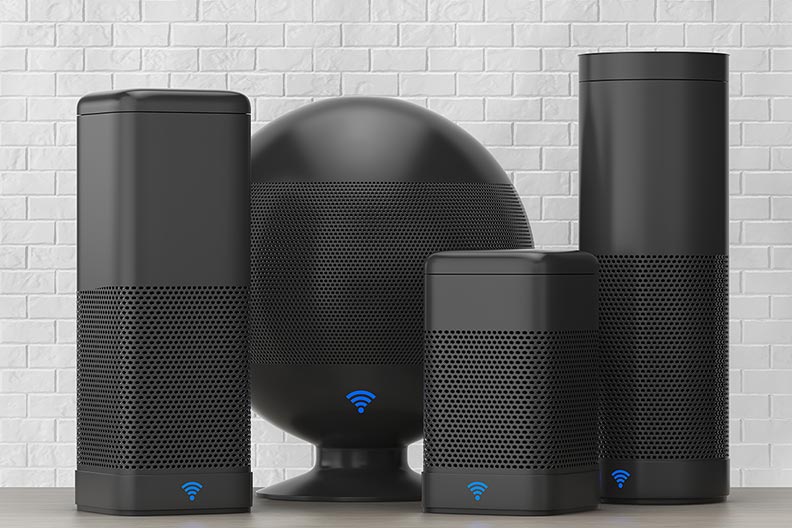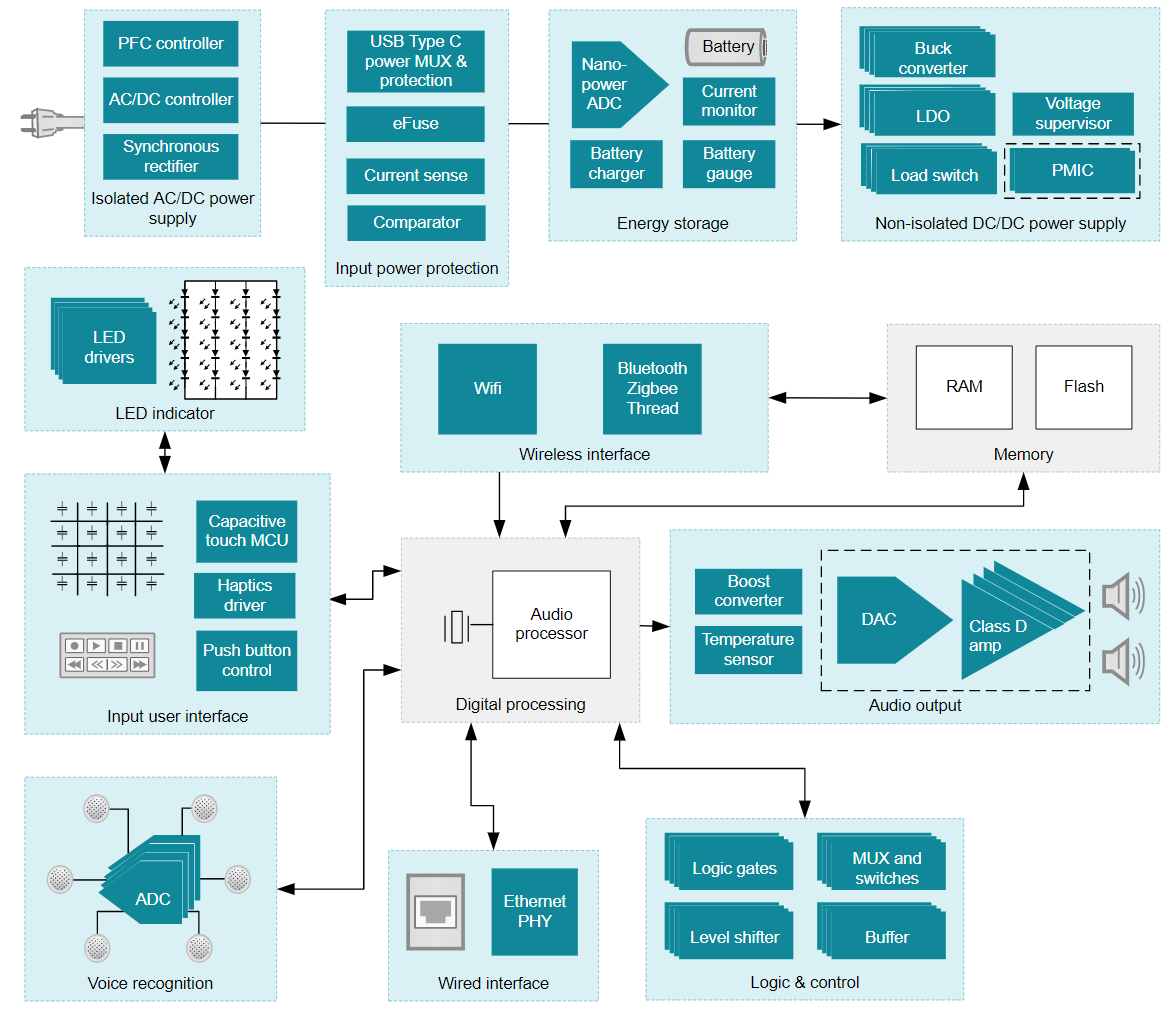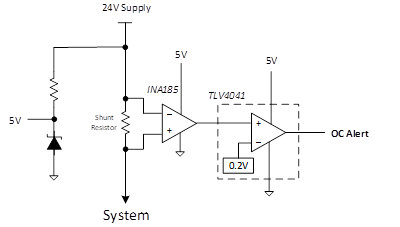SSZT459 june 2019 INA185 , TLV4041 , TPS2595

Smart speakers continue to enhance our homes with cutting-edge voice-recognition artificial intelligence and premium sound quality. When paired with other home automation devices – such as video doorbells, lighting systems, thermostats and security systems – smart speakers and smart displays are fast becoming the control hub for a smart home network.
To keep up with the growing market and stay ahead of the curve, designers are looking to reduce the size and heat dissipation of smart speakers while adding functionality and improving performance. Semiconductor devices that efficiently deliver higher performance in smaller packages become crucial to minimizing board space in space-constrained applications.
The majority of a circuit board comprises key components that directly influence the user experience, such as the audio system on chip, human interface controller for capacitive touch with haptic feedback, and LED driver engines and Class-D audio amplifiers. Other components in a smart speaker system such as power management perform essential tasks that do not directly impact the user experience, but do impact size and cost. It is possible to minimize these components for size while still maximizing performance.
One specific component is the input power-supply protection circuit, shown in Figure 1. Input protection, though sometimes taken for granted in many devices, is a critical circuit in the smart speaker to prevent damage to the entire system during power up or when connected to unreliable power supplies. Smart speakers are powered from either an external AC/DC wall adapter or an internal switched-mode power supply. This circuitry protects any downstream devices from being damaged in the event of a fault condition.
 Figure 1 A Reference Block Diagram
Showcasing the Typical Functions That Make up a Smart Speaker
Figure 1 A Reference Block Diagram
Showcasing the Typical Functions That Make up a Smart SpeakerThe primary concern on the input supply is an unnaturally high voltage or current event. TI has both integrated and discrete solutions to handle overcurrent protection (OCP) and overvoltage protection (OVP).
eFuse devices often handle OCP and OVP, integrating a power metal-oxide semiconductor field-effect transistor to disconnect all downstream circuitry under these fault events. eFuse devices also manage inrush current during startup, ensuring that system voltage increases in a controlled manner. Devices such as the TI TPS2595 offer this protection up to 18 V/4 A in a 2-mm-by-2-mm package.
For OCP, a common discrete implementation involves a current-sense amplifier such as the INA185 to measure the current across a shunt resistor. The output of the INA185 either feeds into an analog-to-digital converter (ADC) to digitize the value for a measurement, or into a comparator to provide an instant alert to the microcontroller. The ADC path offers a precise measurement of the current flowing in the system, but adds delay in reading the measurement due to the sampling frequency of the ADC. The comparator path is about 1,000 times faster (while consuming less power) but only provides a digital output signaling overcurrent, not the actual value of the current.
The ADC method works for systems that need to precisely measure current in a system and have the flexibility to change limits dynamically. The INA185 offers better than ±0.2% full-scale accuracy and is the industry’s smallest current-sense amplifier in a leaded package. Measuring only 1.6 mm by 1.6 mm, the device is a great fit for space-constrained systems that require an optimized board layout.
| Enhance the design of your smart speakers and docking stations | |

|
Learn more in our circuit about fast-response overcurrent event detection in smart speakers and docking stations. |
In smart displays, however, the system voltages are above 18 V, and thus need a faster OCP alert. An integrated eFuse device may not be able to operate in such a system, but the combination of a current-sense amplifier and a comparator can offer the same functionality with increased flexibility while taking up minimal board space. Nanosecond-delay comparators like TI’s TLV4041 consume only 2 µA of supply current and can be powered off a simple Zener diode. When paired, the combined solution of the INA185 and TLV4041 measures 5 mm2 and delivers response times up to 50 times faster than competitive devices.
Using an amplifier like the INA185 with a fast comparator provides a quick and precise OCP alert when the system current exceeds a custom-set threshold. Depending on the system, this limit can be set anywhere from milliamps up to a few amps. The TLV4041 also has a precision (1% over temperature) integrated reference to provide an accurate alert regardless of the current level, all in a 0.73-mm-by-0.73-mm footprint.
The discrete solution shown in Figure 2 saves board space by eliminating the need for an additional on-board regulator, and also works in both low- and high-voltage smart speaker systems. The same circuit works across different speaker models of varying supply voltage levels to further simplify your input power protection designs.
 Figure 2 Functional Circuit Showing How
to Set up the INA185 and TLV4041 to Generate an OCP Alert Signal for
High-voltage Systems
Figure 2 Functional Circuit Showing How
to Set up the INA185 and TLV4041 to Generate an OCP Alert Signal for
High-voltage SystemsThe combined solution of INA185 (2.56mm2) and TLV4041 (0.533mm^2) take up approximately 5mm^2 of board space after including the necessary passive components. This total solution size is 15% smaller than comparable integrated devices that offer current sensing functionality. Moreover, TLV4041 has a delay of just 450ns, which makes TI’s combined solution considerably faster than those that integrate a general purpose comparator alongside a current sense amplifier.
The combined solution of INA185 (2.56mm2) and TLV4041 (0.533mm2) take up approximately 5mm2 of board space after including the necessary passive components. This total solution size is 15% smaller than comparable integrated devices that offer current sensing functionality. Moreover, TLV4041 has a delay of just 450ns, which makes TI’s combined solution considerably faster than those that integrate a general purpose comparator alongside a current sense amplifier.
TI’s broad portfolio covers multiple solutions to minimize input power protection in smart speakers. Whether it is low-voltage speakers requiring an integrated device or high-voltage speakers that could use a discrete implementation, TI provides small-size solutions without compromising performance.
Additional Resources
- This Application Brief discusses the trade-offs of using an amplifier and comparator for power-supply protection in further detail.